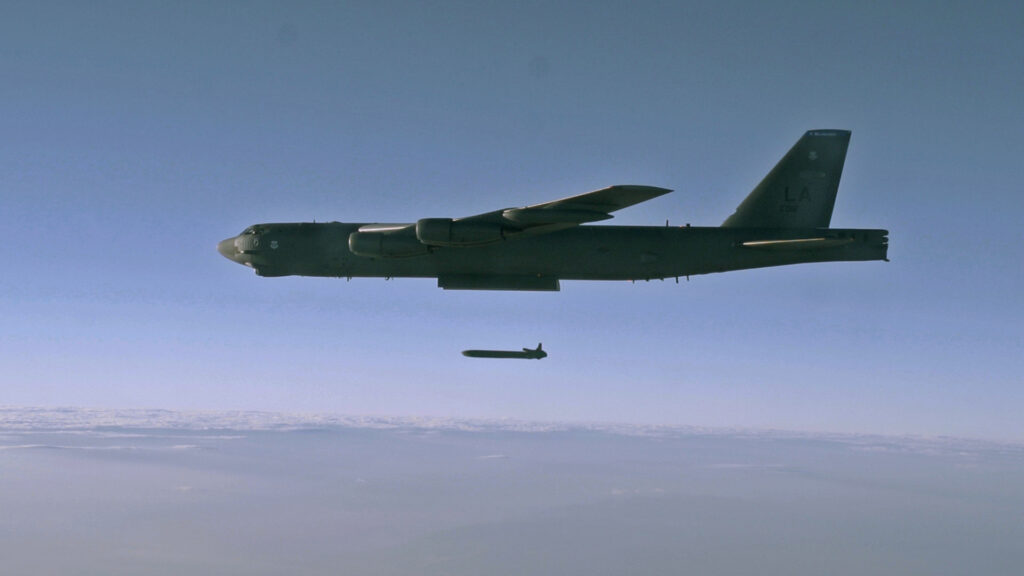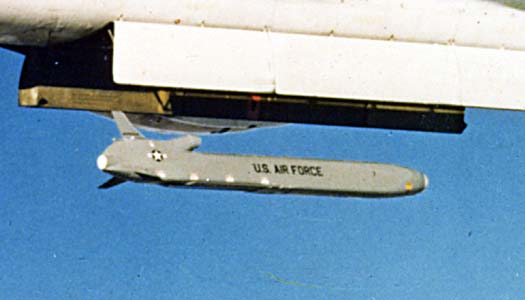New Cruise Missile Crucial To Nuclear Deterrence
Posted on

A B-52 test-fires an unarmed Air-Launched Cruise Missile (ALCM).
Critics of US nuclear modernization claim the Long-Range Stand-Off (LRSO) weapon — an aircraft-launched nuclear cruise missile — can be eliminated without harming America’s security interests. But the LRSO provides America with a unique capability to deter adversaries from using nuclear force and projects credible power while keeping US forces safe.
Updated standoff weapons ensure America maintains a credible and reliable strategic deterrent force. Standoff cruise missiles are launched from a bomber outside defended airspace and penetrate enemy territory — allowing a non-stealthy aircraft like the B-52 to strike well-protected targets.
Outgoing Air Force Chief of Staff Gen. Mark Welsh confirmed the need for standoff weapons for the bomber fleet at least until the new B-21 stealth bomber is fielded over the next two decades. However, even after the B-21 is deployed, other remaining bombers in the US inventory will still need a standoff weapon to hold a large number of targets at risk simultaneously and to enter highly defended airspace without compromising airmen and aircraft. Opponents are wrong when they claim the LRSO is a redundant capability because the B-2 and B-21 bombers are stealthy. First, they forget we will have B-52s in service until the 2040s. Second, the B-2’s stealth, while state of the art for the 1990s, may soon be inadequate to penetrate deep into advanced defenses.

Air-Launched Cruise Missile (ALCM)
To keep these aging aircraft relevant, the existing nuclear-capable Air Launched Cruise Missiles (ALCM) will be replaced to meet US Strategic Command’s operational requirements and to have sufficient spare missiles for testing. The current inventory of ALCM missiles were fielded in 1982 and were only intended to remain in service for 10 years. While multiple life extension programs have kept the missiles in service for more than 30 years, they are difficult to maintain and can be shot down by enemy air defense systems.
The LRSO is designed to address these shortfalls, increase accuracy and deliver new technological capabilities not equipped in the 1982 missile. New LRSOs will be equipped with stealth, giving America access to heavily defended regions. Maintenance of LRSOs will also be easier and cheaper because they will be manufactured with modern components.
The next Air Force chief of staff, Gen. David Goldfein, has stated in Congressional testimony that LRSOs are essential to support the president’s commitment to maintaining a credible and effective nuclear triad. However, some congressional leaders — including Congressman Adam Smith (D- Wash.) and Senator Dianne Feinstein (D-CA) — claim air-launched cruise missiles are destabilizing because they can be launched without warning and come in both nuclear and conventional variants. This dual capability, critics argue, raises the risk that an adversary would mistake an incoming conventional warhead for a nuclear first strike and unleash a devastating response.
But modernizing cruise missiles will not destabilize security. Nuclear cruise missiles were developed during the Cold War to ensure enemies knew America could maintain a credible nuclear response at home and to protect its allies. Cruise missiles were routinely deployed during the Cold War and no evidence exists that the Soviets were worried about their positioning or that these weapons created instability.
It’s also worth emphasizing that Long-Range Standoff weapons do not violate the requirements of the 2010 Nuclear Posture Review. These weapons are not a new capability: They represent an upgrade to the present ALCM fleet. They reassure allies. And they provide a unique and flexible dimension of US nuclear deterrence, because they give our bomber force the ability to signal intent and control escalation even in the face of advanced air defenses.
In the meantime, Moscow is fielding a new KH-102 nuclear cruise missile, which allows Russian bombers to strike the US and its allies from a long distance. Since Russia’s invasion of Ukraine, concerns have heightened regarding the North Atlantic Treaty Organization’s ability to sustain a credible deterrent and mount a viable defense to confront aggression. Russian declarations that nuclear weapons could be used in Europe, including against non-nuclear armed states, along with increasingly aggressive behavior from China, Iran, and North Korea, and potential nuclear proliferation more broadly, demonstrates that America and its allies must have a range of options available to deter threats and respond to future dangers.
In summary, Long-Range Standoff weapons and other elements of the triad ensure the US strategic deterrent remains safe, secure, and effective. This is why the fiscal year 2017 spending bill passed by Congress fully funded the request for the LRSO. The White House should not remove the requirement for the program or propose a delay. Instead, the president should allow the program to reach its first milestone in the acquisition process, and the next chief executive should ensure the program remains intact so that America has credible options when addressing future threats.
Subscribe to our newsletter
Promotions, new products and sales. Directly to your inbox.
